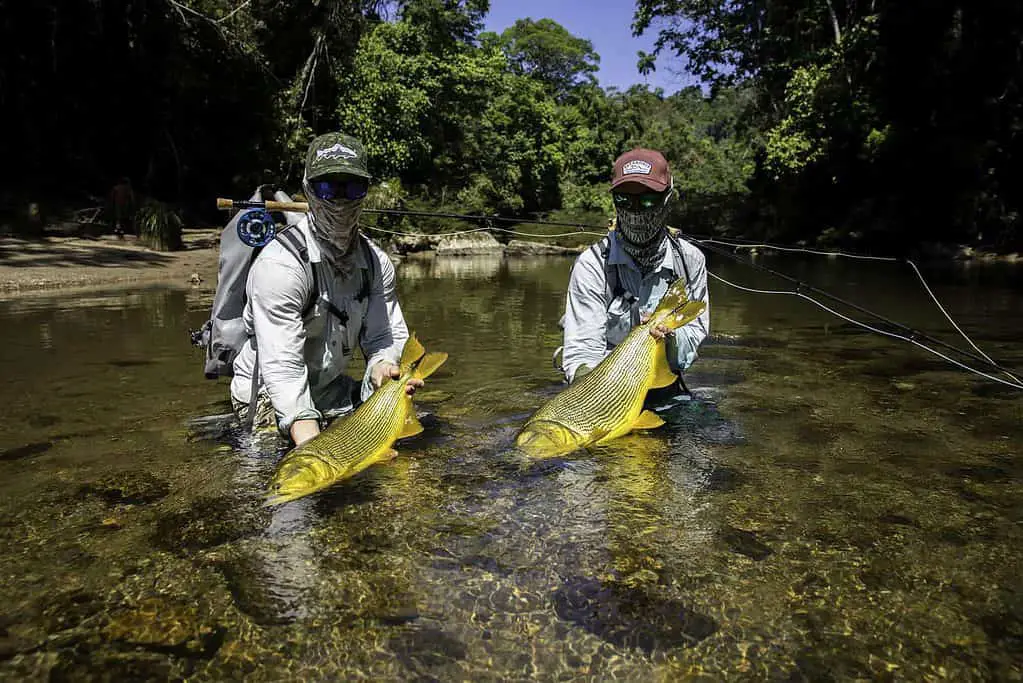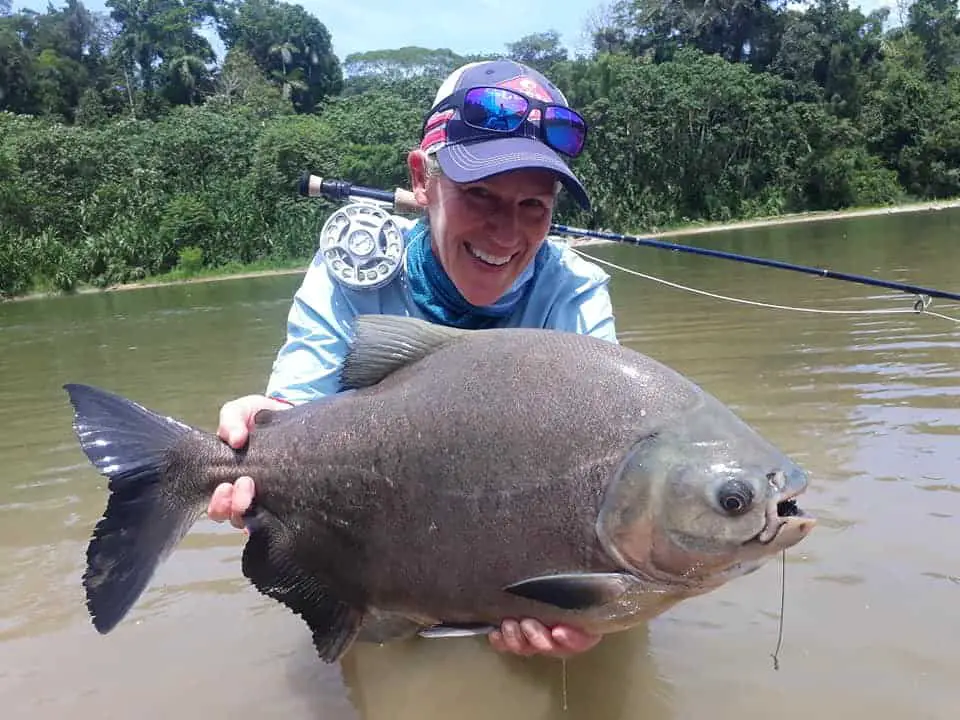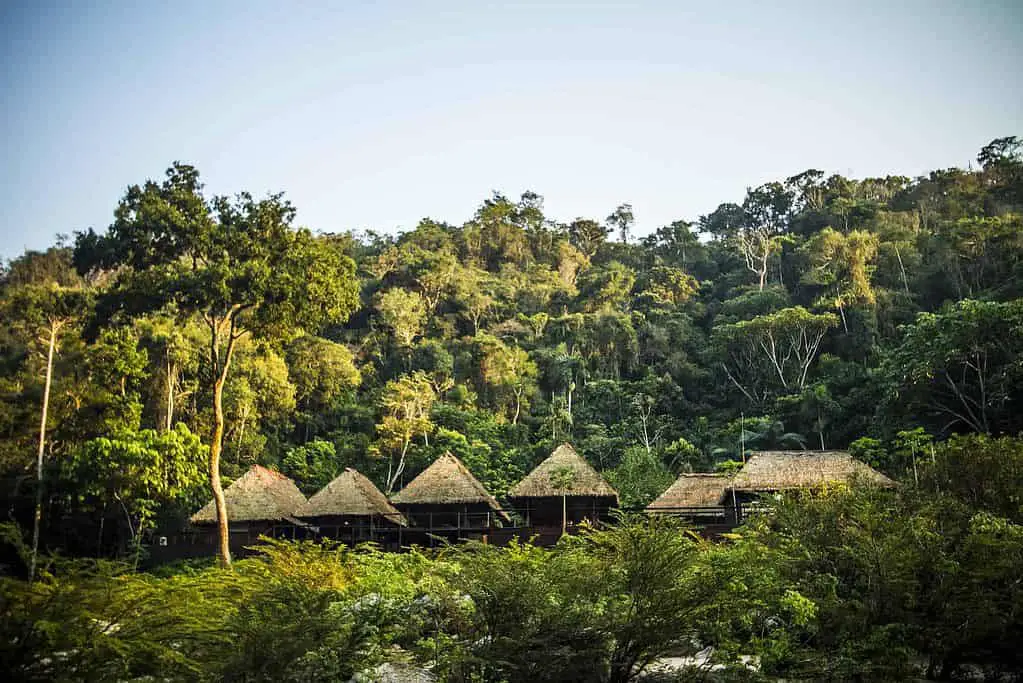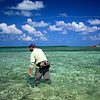Disclosure: Some posts contain affiliate links, which earn us a commission if you make a purchase through them. Positive Fishing © participates in various affiliate networks including the Amazon Services LLC Associates Program.
Sitting in the heart of Bolivia’s slice of Amazon rainforest lies some jungle rivers that require every angler’s attention. If you love exploring new frontiers, getting dirty, trudging through the deep jungle to get to fishing spots, and being guided by indigenous tribesmen, then the fishing in Bolivia will blow your socks off.
It’s not just the experience that makes fishing in Bolivia world-class. It’s also the fish you’re targeting. They are strong, aggressive, acrobatic, and pull a line, unlike any other freshwater species in the northern hemisphere.
The amazing fishing in this landlocked South American country had remained undiscovered for many years, but in the early 2000s, after some serious exploration and investment, rivers full of fish were discovered, and investment into lodges was put into place.
Going fishing in Bolivia should be at the top of everyone’s bucket list, but you can’t just show up, walk through the jungle, and stumble upon rivers full of fish; you’re going to need some insider knowledge.
Key Takeaways
Diverse Fish Species: Bolivian rivers contain a variety of unique fish species to target, including the renowned Golden Dorado and others you are unlikely to have caught before. Each of these is hard fighting and unlikely to have been caught before, which provides excitement and challenges your fishing abilities!
Unique Fishing Environments: The Amazonian region is home to pristine, crystal-clear rivers and streams that are perfect habitats for these game fish. The Tsimane region, for instance, offers a distinct and wild setting that is difficult to access.
Catch and Release Conservation: Many operations in Bolivia practice catch and release to maintain the fish population and ensure the sustainability of the fishery. Anglers are encouraged to handle fish carefully and release them promptly after capture.
Specialized Gear and Techniques: Taking the right gear to cope with the conditions and successfully landing some species should not be underestimated. For many fish, you will need the best line and leaders to cope with sharp teeth and the rugged terrain of the rivers. Wading gear such as boots, belts, and staff are also necessary to ensure a solid footing in the rivers
Preparation for Remote Conditions: Bolivia’s fishing requires being prepared with first aid kits, appropriate clothing, and emergency food, as you will likely be in remote areas. Being relatively fit as well as using experienced guides is highly recommended.
Top Fish To Catch In Bolivia

All the top fish to catch in Bolivia are endemic to South America and live in the freshwater systems that plunge down the jungle-filled slopes of the Bolivian mountains.
They are, quite likely, fish species you have never encountered and perhaps not even heard of, and here they are:
- Golden Dorado
- Pacu
- Yatorana
- Payara
- Peacock Bass
- Arapaima
Golden Dorado are the kings of the rivers in Bolivia, and they look a bit like an enlarged golden trout with sharp teeth and a big mouth that is pretty much always hungry. They grow big, too, reaching 20 lbs quite easily, and when you hook one, boy, it takes aggressively. Expect a huge pull followed by absolutely crazy acrobatics while the fish jumps all around the river, trying to shake the hook.
Pacu have often been described as freshwater permit, and this is due to their shape and shyness, but they will happily eat a well-presented bait in the form of a baitfish or even a berry that they sip off the surface. Once hooked, they will fight like a dog using their wide shape and the current to pose a serious challenge for any angler.
The Yatorana doesn’t grow that big, maybe around 10 lbs at the absolute maximum, but wow, do they fight hard when hooked. They are known for their toughness and are, pound-for-pound, one of the hardest fighting freshwater fish around. While they are not the main target when fishing in Bolivia, they are a great thing to keep you entertained.
Payara, also referred to as “Vampire Fish” due to their huge front teeth, is another awesome fish you can catch in Bolivia. They are long, silver, grow to over 20 lbs, and are an awesome species to target.
The beautiful Peacock bass offers amazing sports with top water eats and a serious fight to follow. They are the biggest and one of the hardest-fighting bass species.
The Arapaima, revered as the ultimate catch among Amazonian fish species, are sought after by anglers worldwide. They reside in secluded water bodies such as lagoons and lakes adjacent to the Amazon River. The presence of Arapaima is often betrayed by their characteristic surfacing behavior to gulp air, making them noticeable to those seeking their whereabouts. Given their size, they are super strong and require careful handling.
Conservation efforts are in place through a catch and release policy, ensuring that these fish are promptly and carefully returned to the rivers after capture,
These formidable giants can reach over 4.5 meters and tip the scales at over 500 pounds. The prime areas are teeming with Arapaima, and they can be targeted with various methods, usually with large flies or artificial lures. Landing an Arapaima on a fly is a crowning achievement for any angler; heavy gear is required with a 10-12-weight rod, a matching reel, and huge flies.
It may be a bit of a surprise, but many of these species thrive and can be caught at Gillhams Fishing Resort in Thailand, over 18,000 km away. Pacu, arapaima, red-tailed catfish, and payara are hardy, strong fish and can survive in multiple river and lake systems.
Where To Go Fishing In Bolivia

All the great fishing in Bolivia is around the highlands and jungles. If you’re looking to focus on Golden Dorado, Pacu, and Yatorana, then you best stick to the rivers in the jungles around Puerto Márquez, which are in the indigenous lands and run by the Indians living there.
If you’re looking for Payara and Peacock Bass as well as Pacu and Yatorana, you best head to the other side of Bolivia and fish the rivers in the Reserva Forestal Itenez. These are also reserves that belong to the indigenous Indians who welcome anglers to fish the hundreds of miles of rivers.
The fishing destinations in Bolivia are wild as you will be deep in the Amazon jungle and thus surrounded by nature and wildlife, plus, in some cases, guided by the indigenous Indians of the areas.
Along the way, you’ll see wildlife like macaws, parrots, storks, geese, jaguars, tapirs, swamp deer, black cayman, capybaras, and pink river dolphins. If you have dreamed of seeing the Amazon and want a fishing adventure to go with it, then Bolivia is definitely the place for you.
When To Go Fishing In Bolivia
When it comes to having a successful fishing trip, a lot of your success is based on being there at the right time. While we can’t control the weather (for example, when I was living as a guide in Seychelles, I saw several weeks totally rained out during the dry season!), it still helps to try to plan and be there at the best time available.
Since all the fishing in Bolivia is in rivers, you want to be there in the dry season when the rivers are low and clean. This allows the fish to see your bait, for you to sight fish, and to have the best fishing possible in the rivers.
The dry season in Bolivia runs from June to October, which is the time to be there. If you experience some rain, you should expect the rivers to go from crystal clear to a muddy tea color, but you should be able to find some clear tributaries that deliver in the dry season.
Best Methods For Catching Fish In Bolivia
You have three different options when it comes to how to catch fish in Bolivia, and these include spin fishing and fly fishing. Not every fishing lodge in the country actually allows all these forms of fishing, though; some are fly fishing only, while others allow all types of fishing methods.
Fly Fishing for all the species mentioned above is by far the best way in my eyes. Imagine casting a fly across a small, clean river in the jungle resembling a trout stream. That is awesome enough, but when you strip your large brush fly across the river, suddenly it’s engulfed by a golden dorado that starts jumping all over the pool. Sounds amazing, doesn’t it? Now, add all the other species to a similar scenario, and you’ll see why fly fishing is my favorite form of fishing.
Spin fishing in the rivers is also a lot of fun. Casting poppers for peacock bass whilst seeing them eat off the surface and cranking baits across rivers to have them engulfed by golden dorado and payara is something you will never forget.
How To Book Your Fishing Trip To Bolivia

best lodges in the country
Booking a fishing trip to Bolivia is easy, as the world-class lodges will take care of everything from your fishing license to your internal flights.
All you need to do is book your international flights to La Paz or Santa Cruz; they will do the rest.
Here are the lodges I personally recommend:
Tsimane Lodges
Tsimane Lodges were the guys to put fly fishing in Bolivia on the map, and they organize all the fishing around the Puerto Márquez area for golden dorado, pacu, and yatorana.
Their lodges are impeccably run, their guides are excellent, and they look after the indigenous tribes and the environment as well as possible. Staying at Tsimane isn’t cheap by any means, but you will experience some of the wildest fishing on the planet.
They have three different lodges to choose from, all in different parts of the local river system. You’ll get a guide and a boat between two people to spend your days exploring the water and catching some amazing fish.
If you are familiar with Aardvark McLeod (I have regularly recommended using them to book fishing vacations), they have some awesome packages to Secure, Pluma, and Agua Negra.
Cano Negro
Cano Negro fishing lodge sits on the eastern side of Bolivia in the Reserva Forestal Itenez, and this is the best place to go if you want to use spinning gear and catch species such as payara and peacock bass as well as catfish, pacu, and yatorana.
They have a lovely lodge in the middle of the Amazon with cabins, a restaurant, and over 100 miles of river to explore. Their guides are great, and the gear they [provide is top-notch, and they will have you catching fish all day long!
Staying at Cano Negro is a lot more affordable than Tsimane, but there is no golden dorado around, and if you’re going to Bolivia, then you should really have the chance to catch one of them too.
The Fishing Regulations In Bolivia
To go fishing in the indigenous reserves, you’re going to need to pay an Indian Community Tax, which is around $500, to fish in their rivers, which is totally fair enough in my eyes. While this is a bit more expensive than other places, it gives you unrestricted access to the best fishing in Bolivia.
This price won’t be included in your booking with either of the lodges above, but they will assist you with paying it on your way to the lodge.
Popping Off
Thanks for reading my article about fishing in Bolivia. I hope you enjoyed it and are ready to book a fishing trip to Bolivia. If there is one fishing trip on the planet that combines exploring one of the most diverse regions on the planet with explosive fishing, it’s going on a trip to Bolivia!
You can read more of my articles on fishing in South America, including fly fishing in Argentina and over 40 other countries worldwide.
- Top Tips For Fishing With Feathers - January 15, 2025
- How To Fish For Flounders: Tips, Rigs, & Baits - March 27, 2024
- Fortis Wraps Fishing Sunglasses: The Affordable Option For Anglers - January 25, 2024

